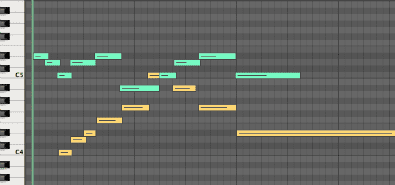Oliver Curry explains the theory of counterpoint, with help from JS Bach, Steve Reich, The Orb, Lorn and children’s nursery rhymes.
Counterpoint refers to the relationship between two or more distinct, independent melodies playing simultaneously, complementing each other. It is the ‘independent’ aspect of the melodies which separates the idea of counterpoint from that of accompaniment or harmony – the melodic parts involved in any ‘contrapuntal’ relationship are distinct melodies in their own right.
Certain forms of counterpoint in classical music have often followed a number of rules relating to aspects of the melodies in question – such as which notes could be placed where in the phrase, how many notes one melody plays per each note of the other melody and the specific intervals that should (or should not) occur between the separate melodies.
However, whilst some of these are often still adhered to in dance music, in this Passing Notes we aren’t going to focus on the ‘rules’, but rather on how we can apply a basic understanding of the concept of counterpoint melodies to electronic tracks.
Classical and contemporary examples
Counterpoint has been employed in western music for well over 1,000 years. The first written examples appear in Musica enchiriadis, a Latin treatise on music published in the late 9th century, although it’s reasonable to assume that counterpoint had been employed even before then.
Counterpoint appears in numerous movements of classical music, but the technique was notably employed in the baroque music of the late 17th and early 18th centuries; Johann Sebastian Bach’s compositions in particular provide countless examples. Let’s consider this performance of Bach’s Prelude and Fugue in A minor (BWV 543), written for church organ around 1708:
Note how the layers of melody overlap and interact within the same key, creating harmonies as the piece progresses. What’s important to understand here is that the separate melodic lines aren’t simply playing identical patterns; this should be relatively easy to follow by watching the movement of organist John Scott Whiteley’s left and right hands. (At this stage it’s not necessary to understand the specific details of the interplay of these contrasting parts, but if you’d like to visualise the complexity of counterpoint with multiple voices of polyphony, Stephen Malinowski’s videos are a good starting point.)
Although the melodies must contrast at any given time in the arrangement for it to be considered counterpoint, one of the most simple and effective ways of creating counterpoint is to duplicate a melodic line of, say, four bars but to separate the two identical melodies by a bar. Bach’s compositions regularly use this technique, in which a melodic line is echoed a bar or two later, occasionally in a different octave. The effect is similar to the ’round’ technique often employed when singing children’s nursery rhymes.
Steve Reich’s Electric Counterpoint is an interesting contemporary example. Written for jazz guitarist Pat Metheny and first recorded in 1987, the minimalist piece is composed for 13 guitars. The piece can be performed live by an ensemble, or (as in Metheny’s case) as a solo guitarist playing over a pre-recorded multi-track tape of the other parts.
We can hear in the third movement how the parts overlap:
Reich has influenced many dance music producers (Electric Counterpoint itself has been sampled by artists as diverse as The Orb and Nero), but what’s interesting here is to consider how the techniques employed in Electric Counterpoint are commonplace in electronic music regardless of whether Reich is a direct influence: multi-tracked monophonic parts, repetition, minimalism and the separation of elements by subtle differences in timbre are fundamental to so much contemporary electronic music. All four techniques can be used to good effect when we create our own counterpoint.

08.28 PM
Superb as ever. Thank you.
10.36 PM
very useful!
11.08 AM
You guys are great! Thanks!!!
06.37 PM
really nice. If anyone else is wanting to get deeper into counterpoint you should check this book out
http://www.opus28.co.uk/Fux_Gradus.pdf
Its really old and super hard read lol but definitely useful if you can get through it! Good examples if you can read basic notation. I love this site though
10.36 AM
Just started to study counterpoint. A vast subject, but I really enjoyed the summary here and the examples of modern artists using it.
10.29 AM
E – Thank You VERY much for this wonderful book, this truly seems to be a read worthwhile!
06.30 AM
youtube video is missing